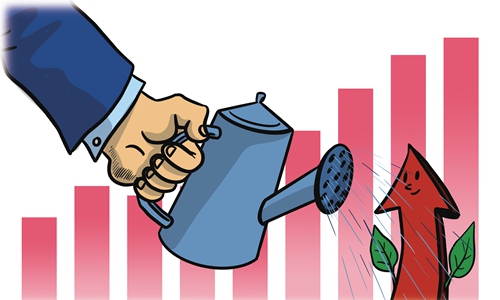HOME >> SOURCE
Herding an economic revival tentatively, cautiously
By Li Hong Source:Global Times Published: 2020/3/15 21:30:20

Illustration: Luo Xuan/GT
It is heartening to see that the ferocious spread of the coronavirus has been effectively contained in China, which has been evidenced by the single-digit daily new infections in the worst-hit city of Wuhan. Other provinces and cities in the country have largely been cleared of the disease.
The whole nation is scrambling to fuel the engine of its dormant economy. Preparation for the annual Canton Trade Fair, to be held in April, is now in full swing. Residents in Qianjiang, Hubei Province were celebrating with fireworks as the city is allowed the restart of business operations. On Friday, the Ministry of Industry and Information Industry announced that 80 percent of the blue- and white-collar workers have returned to their jobs.
The government's strident measures to cordon off Wuhan and Hubei and shut down the bulk of economic and social activities have worked. After two months of distressful days huddling at home, people are coming to the streets, shopping and smiling.
However, this country must be very cautious and on high alert to prevent from reigniting the disease, and keeping virus patients from slipping out of watch and causing cluster infections.
To herd a smooth and quick economic revival, China's policymakers ought to revisit the portfolio of its policy tools. As foreign trade will perhaps be mostly curtailed with Europe and North America, which are now embroiled in an incessantly wild spread of the pandemic, China needs to pivot to enlivening domestic consumption and ramping up infrastructure investment to fire up a sluggish economy.
Last week, the central government worked out a policy guideline to remove a policy that seriously restricts car consumption. It could be even bolder by formulating more preferential policies - such as doling out vouchers or subsidies to incentivize vast consumers to purchase other big-ticket items, including smart television sets, refrigerators, washers, advanced laptops and tablets.
China boasts of an auspiciously high savings rate among all major economies in the world. The online sales on November 11, 2019, which saw Alibaba Group and JD.com sell a combined $67.5 billion worth of goods in a single day, is a testament to the country's mighty consumption power.
And, to inspire home sales in over 700 Chinese cities, China's financial authorities could move to reduce the loan prime rate (LPR) by 10 to15 basis points so that lenders could issue mortgages at a lower rate. Some tier-2 and tier-3 cities may encourage more residents to buy their first homes, by giving government subsidies or asking the banks to reduce the down payment, which is now at an elevated 30 percent of a house's price.
The central government's strict restrictive policies on purchasing urban properties should be loosened.
And, simultaneously, governments at varied levels should make sure the rising trend of the workers' disposable income in their cities should not be lowered, so long as the enterprises return to full-capacity operation. It is wise to scrap some taxes and fee charges on all types of business - state-owned, private-run and foreign-invested - in the first half of the year so that they don't lay off jobs and trim workers' salaries.
Meanwhile, the government, the central bank in particular, needs to keep an eye on the country's stock market so that it won't follow the whiplash path of Wall Street and ruin the middle class families' savings and investment in equities.
In addition to boosting home spending power, Beijing could also work out a proactive fiscal stimulus plan of a moderate scale to advance construction of the world-renowned infrastructure projects, including expansion of expressways, sea ports, airports, high-speed rails, giant water-diversion canals, and hydro- and nuclear power stations.
And, to groom smooth development of China's future competitive power in the world, the government ought to spend heavily on strengthening the so-called "new infrastructure projects" - namely, ultra-fast 5G wireless networks, next-generation computing data centers, facilities for artificial intelligence, and advanced industrial robotics.
Following a nightmarish first two months of 2020 due to COVID-19, China has 100 reasons to believe in itself, and the government should be all the more clearer in its heart that "Made in China 2025" is the righteous course for China to stand up stronger, and that there is always the iconic Belt and Road Initiative to rely on.
The author is an editor with the Global Times. bizopinion@globaltimes.com.cn
Posted in: INSIGHT,COLUMNISTS